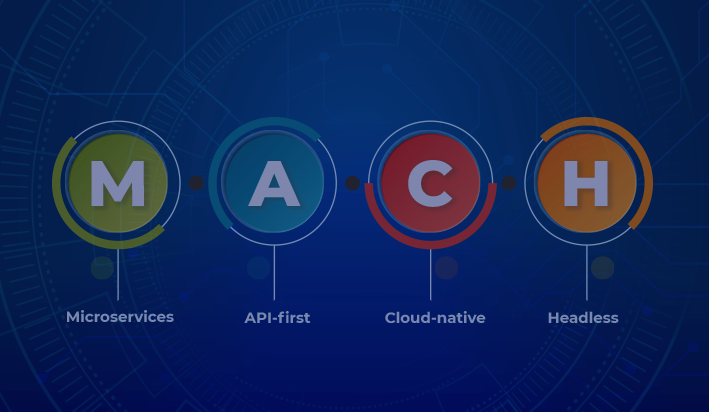As customer expectations shift, companies face a pivotal choice: provide a unified experience across all channels or risk falling behind. This entails robust product pages, fast site loading, and seamless navigation. A responsive frontend and an adaptable backend become essential to meet these demands, and both must swiftly respond to changing requirements.
A McKinsey research says that 71% of customers want companies to provide customized solutions, and when businesses fail to do so, 76% of customers feel frustrated.
This shows how important it is for brands to give customers a personalized user experience. Hence, companies are swiftly adopting MACH-based architecture, drawn by its modular design that facilitates personalized experiences, scalability, and adaptability to ever-evolving customer needs.
This blog delves into MACH Architecture’s significance, advantages and uncovers best practices. We aim to paint a comprehensive picture of how MACH Architecture is a beacon for crafting efficient, robust, and innovative digital software experiences.
What is MACH architecture?
MACH stands for Microservices-based, API-first, Cloud-native, and Headless. These four modern technology principles lay the groundwork for an open and advanced digital architecture system, emphasising flexible design, smooth interaction, and adaptability.

Let’s quickly walk through the MACH architecture definition.
Microservices-M
Microservices are small independent applications performing a specific business task. They can be created, deployed, and scaled independently. This approach breaks down a software application into smaller parts, essentially independent services that communicate through APIs.
APIs (Application Programming Interfaces)-A
APIs enable different software components to communicate with each other. An API-first strategy means designing software focusing on seamless communication and APIs as a foundation. Unlike the past where communication between programs was an afterthought, the MACH approach inherently prioritises it.
Cloud-native Architecture-C
Embracing the cloud platforms to host the applications and constructing using cloud providers’ services, allows easy scalability, resilience, and deployment. This approach lets businesses utilise the latest cloud advancements, ensuring their technology remains up to date.
Headless – H
The headless approach promotes front-end adaptability across various platforms, mediums and devices. It does this by detaching the frontend user interface from the backend operations. This separation offers flexibility by allowing independent development and maintenance of frontends and backends. Multiple frontends can be supported using the same backend API, making it a versatile and efficient approach for modern software architecture.
Part of this groundbreaking movement is the MACH Alliance, a consortium of like-minded organisations championing the MACH principles. The alliance acts as a unified force, striving to promote the adoption of MACH architecture across the industry. Through research, collaboration, and advocacy, the MACH Alliance empowers businesses to harness the potential of MACH software architecture for unparalleled innovation and customer-centric solutions.
Advantages of MACH Architecture
Enhanced Scalability
MACH architecture excels in scalability by enabling individual services to be easily expanded or contracted based on application and business needs. Integrating application components into smaller, independent services allows efficient scaling and resource allocation. This flexibility ensures that applications can handle increased workloads, adapt to changing demands, and deliver optimal performance.
Flexible and Modular
MACH architecture, representing the ideals of flexibility and agility, is designed to be open and future-proof. It embraces a composable approach, with each component being pluggable, scalable, replaceable, and continually improved. This modular approach enables organisations to achieve faster iterations, easier maintenance, and adaptability to meet evolving technology trends and customer demands.
With MACH’s modular and composable design trait, developers can work on independent services without affecting the overall system. Such modularity supports parallel development, enhances code reusability, and simplifies troubleshooting and debugging, making MACH architecture a robust choice for modern software systems.
Cost-Effectiveness
MACH architecture can help optimize costs and resource allocation. By adopting a microservices-based approach, businesses can allocate & automate resources based on specific service requirements independent of other services. This granular control over resource allocation and the ability to independently scale services allows organisations to optimize costs and achieve higher efficiency in resource utilisation.
Seamless Integration
MACH architecture follows an API-first design approach, making integrating external services and systems more accessible. The architecture promotes the usage of well-defined APIs, enabling seamless integration with existing systems and third-party applications. This facilitates interoperability, accelerates time-to-market, and allows businesses to leverage the functionalities and data of other services without heavy customization.
Best practises in Integrating MACH Architecture
Here are some essential best practices that will steer you toward successfully integrating MACH principles into your ecosystem.
Comprehend MACH Principles
Gain a clear understanding of nuances of Microservices-based, API-first, Cloud-native, and Headless principles that underpin MACH Architecture.
Assess Existing Landscape
Evaluate your current microservices setup to identify areas that can benefit from MACH Architecture’s modular and adaptive approach.
Strategic Planning
Formulate a comprehensive integration strategy, outlining objectives, timelines, and resources needed for a successful transition.
Team Training
Train your development team on MACH principles, emphasising the significance of modular design, API-first communication, cloud-native infrastructure, and decoupled frontend-backend architecture.
Start Small
Begin integration with a specific microservice or a particular aspect of your application. This controlled approach minimizes disruption and allows for gradual adjustment.
API Integration
Implement APIs as the foundation for communication between microservices. Design APIs that align with MACH’s emphasis on seamless interaction.
Cloud-native Adaptation
Leverage cloud services and technologies to align your microservices with the cloud-native aspect of MACH Architecture, enhancing scalability and flexibility.
Headless Implementation
Apply the headless approach to detach frontend and backend functionalities. Develop APIs that enable independent evolution of both components.
Testing and Iteration
Rigorously test the integrated components for performance, scalability, and compatibility. Iterate as needed to fine-tune the system.
Continuous Monitoring
Implement robust monitoring and observability tools to track the performance and adaptability of your MACH-enabled services.
Feedback Loop
Establish a feedback loop involving developers, operations, and end-users to improve the integration and address any challenges continuously.
Documentation and Training
Document the integration process, best practices, and lessons learned. Provide ongoing training to ensure the team remains proficient in maintaining MACH microservices.
Following these best practices will pave the way for a successful and seamless integration of MACH Software Architecture.
MACH Architecture in Action
While MACH software architecture promises many benefits, it is essential to go beyond mere assertions. Let us dive into the practical realm and see how MACH technologies come to life through real-world implementations.
Amazon
The vast realm of online retail is no stranger to MACH Architecture, with Amazon as a prime example. A pioneer in adopting MACH, Amazon’s early website versions followed a monolithic approach, which caused sluggish development and feature releases. However, a transformation arrived with the embrace of MACH architecture in 2006. Amazon’s journey exemplifies how MACH in e-commerce can invigorate digital experiences and align with modern architectural principles. Amazon Web Services (AWS) has teamed up with the MACH Alliance, underlining its commitment to this progressive architectural approach.
Uber
Navigating complex ride-sharing and dispatch systems, Uber chose the MACH route to revamp its architecture. With its customer-facing interface and driver-centred dispatch library relying on numerous microservices, the power of APIs takes centre stage. These APIs link various functions, from passenger management to payment support, creating a well-integrated system. Uber’s shift to MACH highlights the versatility of this approach in managing intricate ecosystems and fostering efficient real-time communication between users and applications.
In a nutshell, MACH-based Architecture is fundamentally changing how digital systems communicate with people and focuses on providing the best experiences all the way. This innovation-driven MACH framework fosters rapid development while encouraging independent microservices for modularity. Furthermore, MACH seamlessly integrates third-party services & elevates omnichannel experiences, resulting in more satisfying user engagement and an amplified digital journey.
Ultimately, MACH Architecture reshapes the digital landscape, harmonizing personalization, agility, scalability, versatility, innovation, and integration into a symphony of user-centric excellence. Want to know how you can instil stellar performance through modernizing your digital application with Microservices? Feel free to contact us for a discovery discussion.













